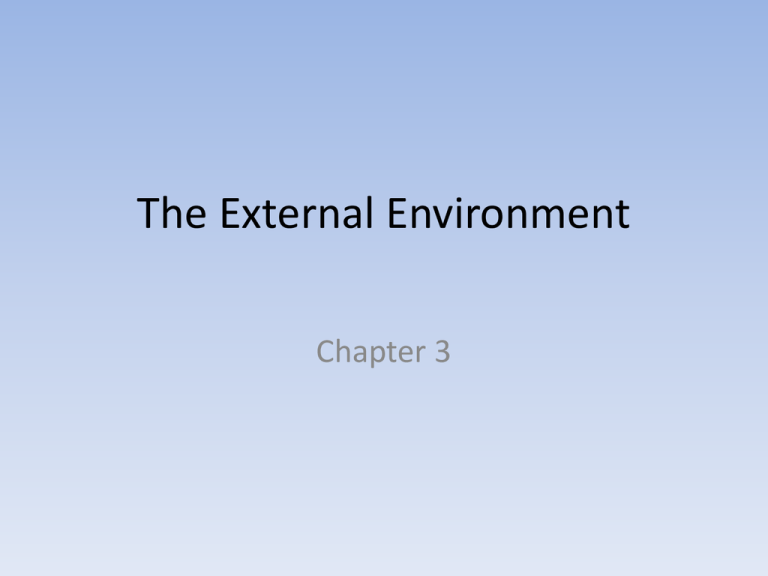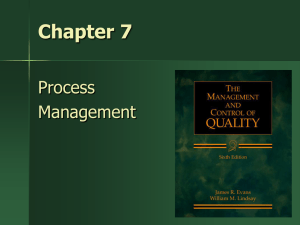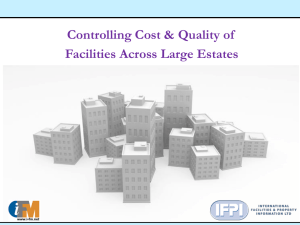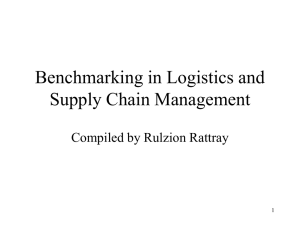Chapter 3
advertisement

The External Environment Chapter 3 Upon completion of this chapter, you should be able to: • Identify opportunities and threats. • Use a range of tools to analyse the business environment. • Access the significance of environmental factors. • Develop linkages and networks to strengthen your organization in its environment. • Evaluate the key success factors for your organization. • Benchmark your organizations performance and financial ability. • Define the competitive environment of your industry in terms of markets, boundaries, competitors and technologies. To cope with what are often ambiguous and incomplete environmental data and to increase their understanding of the general environment, firms engage in a process called external environmental analysis. Completing this analysis is a difficult, yet significant, activity. In performing an analysis of your organizations environment, the following tools and techniques will be essential: • Key success factors • Benchmarking • Five force analysis • Four links model • PESTLE analysis • Scenario building Exploring The Environment • Refer to diagram on page 76. • As Johnson, 2005 illustrate, there are found to be difficulties associated with developing a connection between the strategy and its environment. Perscriptive vs Emergent debate – Despite uncertainties, the environment can usefully be predicted. Environment maybe turbulent and therefore, predications may be inaccurate and therefore serve no useful purpose. • Uncertainty – Environment will always posses an element of uncertainty. New strategies have to be undertaken against a backdrop that cannot be guaranteed and this difficulty must be addressed as corporate strategies are developed. • Range of Influences – In theory, every element of an organisation’s environment may influence corporate strategy. This makes it difficult for individuals and organizations to manage every item. A solution to this is to identify the factors for success in the industry and then to direct the environmental analysis towards these factors. – When analyzing the environment, it is also important to draw a distinction between two types of results from the analysis: – Proactive outcomes: the environmental analysis will identify positive opportunities or negative threats. Proactive strategies will then be developed to explore and cope with the situation. – Reactive outcomes: environmental analyses will highlight important strategic changes over which the organization has no control but to which, if they occur, it will need to be able to react. Opportunities and Threats • An important objective of studying the general environment is identifying opportunities and threats. An opportunity is a condition in the general environment that if exploited, helps a company achieve strategic competitiveness. • A threat is a condition in the general environment that may hinder a company’s efforts to achieve strategic competitiveness. Defining Your Industry • Industry is made up from: • Customers or buyers – who purchase goods or services from your organization. • Suppliers – who supply services or products to your organization. • Competitors – those who are competing to win your customers. • Therefore it is in an organizations best interest not to lose sight of the importance of customers when searching for competitive advantages for your organization. One way of linking customers to your organization is by analyzing key success factors. Key Success Factors (KSF) • KSFs or critical success factors – are the resources, skills and attributes of the organizations in the industry that are essential to deliver success in the market place. • KSF for organizations are common within industries and do not differentiate between companies. • Examples – refer to page 81. • KSFs do however differentiate between industries and that is why it is important to identify them for particular industries. KSFs can be used to assess the ‘health of the business’; the indicators of success or failure. By comparing your organisation’s KSFs with those of your main competitors you can identify possible relative strengths and weaknesses which may indicate areas for improvements. • Examples – refer to page 81 Benchmarking • Defined as a sophisticated method of pinpointing areas of improvement in every business process. • Recent definition – “benchmarking is the search for industry best practices that lead to superior performances.” • Best practices refer to business practices that outperform all other business practices in any specific industry. • Best practices can be achieved through innovation inside the organization. • Benchmarking is a methodology to assist in improving the processes. Benchmarking methodologies • Two most widely used: – Competitive benchmarking – Process benchmarking • Competitive benchmarking – if you are trying to position your performance rank within your industry, competitive benchmarking is the best bet. With competitive benchmarking you measure the performance of your organization against that of your competitors. • Process benchmarking – measures business processes or practices that are importance to the performance of your organization and does this across industries. Advantages of benchmarking • Benchmarking can be effective at all levels of operations. • Recklies, 2006 – benchmarking helps you to – – – – Expose areas where improvement is needed Pinpoints areas for cost reduction It assesses performance objectively You can use it to test whether your improvement initiatives have been successful – Furthermore benchmarking encourages striving for perfection and innovative thinking, it can help you to create a better understanding of your industry and it is the most effective tool to identify best-in-class business practices, with a view to their adoption. – It eliminates the guesswork by studying the existing processes and enablers that will lead to best practices and it encourages innovation by looking outside your industry’s zone of comfort. – Although benchmarking is a useful tool for achieving operational effectiveness, it is important to realize that operational effectiveness alone does not lead to sustained competitive advantage. Five Forces Analysis • Identifies 5 basic forces that can act on the organization: – – – – – The bargaining power of suppliers The bargaining power of buyers The threat of potential new entrants The threat of substitutes The extent of industry competitors • The objective of this analysis is to investigate how the organization needs to form its strategy in order to develop opportunities in its environment and protect itself against competition and other threats. • Refer to diagram page 87. Bargaining Power of Suppliers • Suppliers’’ comprises all sources for inputs that are needed in order to provide goods or services. • Supplier bargaining power is likely to be high when: – – – – – Market is dominated by few large suppliers No substitute Supplier customers are fragmented Switching costs from one supplier to another Possibility of supplier integrating forwards to obtain higher prices and margins Bargaining Power of Customers • Bargaining power of customers determines how much customers can impose pressure on margins and volumes. • Customers bargaining power is likely to be high when: – – – – – – – – – When large volumes are bought Supplying industry comprises of a large number of small operators The supplying industry operates with high fixed costs. Products easily substituted Customers have low margins and price-sensitive Customers could produce products themselves Product is not strategical importance Customers know about the production cost Possibility of backward integration Threats of New Entrants • Competition will be higher when it is easy for other companies to enter the industry. • New entrants could change major determinants of the market environment at any time. • There is always a latent pressure for reaction and adjustment for existing players in the industry. • Threat of new entries will depend on the extent to which there are barriers to entry. These are typically: – Economies of scale (minimum size requirements for profitable operations) – High initial investments and fixed costs – Cost advantages or existing players due to experience curve effects of operation with fully depreciated assets. – Brand loyalty of customers – Protected intellectual property like patent, licenses etc – Scarcity of important resources, eg. Qualified expert staff – Access to raw materials is controlled by existing players – Distribution channels are controlled by existing players – Existing players have close customer relations eg from long-term service contracts – High switching costs to customers – Legislation and government action. Threat of Substitutes • Threat of substitutes exist if there are alternative products with lower prices of better performance parameters for the same purpose. They could potentially attract a significant proportion of market volume and hence reduce the potential sales volume for existing players. • The threat is determined by factors like: • Brand loyalty of customers • Close customer relationship • Switching costs for customers • The relative price for performance of substitutes • Current trends Competitive Rivalry Between Existing Players • This describes the intensity of competition between existing players in an industry. • High competitive pressure results in pressures on price, margins and hence, on profitability for every single company in the industry. • Competition between existing players is likely to be high when: • There are many players of about the same saiz • Players have similar strategies • There is not much differentiation between players and their products – there is much price competition • Low market growth rates • Barriers for exit is high Use of information form Five Forces Analysis • Five Forces Analysis can provide valuable information for three aspects of corporate planning. • Statistical Analysis – Allows determining the attractiveness of an industry – Provides an insight on profitability thus it supports decisions about entry to or exit from an industry or market segment. • Dynamical Analysis – Reveal insights about the potential future attractiveness of the industry. • Analysis of Options – With the knowledge about intensity and power of competitive forces, organisaitons can develop options to influence them in a way that improves their own competitive position thus allows a systematic and structured analysis of market structure and competitive situation. Influencing the Power of Five Forces • After the analysis of current and potential future state of the five competitive forces, managers can search for options to influence these forces in their organisation’s interest. • Although industry-specific business models will limit options, the own strategy can change the impact of competitive forces on the organization. • Objective is to reduce the power of competitive forces. Criticisms of Porter’s Five Forces Model • The model assumes a classic perfect market • The model is best applicable for analysis of simple market structures • The model assumes relatively static market structures • The model is based on the idea of competition – it does not take into consideration strategies like strategic alliances, virtual enterprise networks, etc • Overall it is not able to take into account new business models and the dynamics of markets. The Four Links Model • Stresses the importance of forming links with rivals to achieve the following: • Sustainable competitive advantages • Produce lower costs • Deliver more sustainable relationship with parties outside the organization • Refer to diagram on page 96 Informal links and Networks • These links are created for a mutual or common purpose that are not legally binding and may occur by accident or by design. • Eg. Contract, a local chamber of commerce, etc • Often organizations outside these networks lose out on competitive advantages. Formal Co-operative Linkages • These are boung together by some form of legal contract and usually include joint ventures and partnerships involving a higher degree of formality to ensure permanence of lingkages. Strengths and weaknesses should be measured in terms of their depth, longevity and degree of mutual trust. Government Links and Networks • These usually involve relationships with a country’s national parliament, regional assemblies and the associated government administrations. • Such links may be vital in tax and legal matters e.g. interpretation of competition law. Complementors • Those companies whose products add more value to the products of the base organization are known as complementors. Eg. Play station games for the Sony Play Station. PESTLE Analysis • • • • • • • • • • • Helps to identify forces in the macro enviroment that are affecting the business now and are likely to continue to do so in the future. Checklist of issues: Political – government policies, attitudes to industry, competition, taxation, etc Economic – GNP and GDP, inflation etc Socio-cultural – demography, consumerism, education and health, income distribution, etc Technological – government spending on research, adoption of new technology, etc Legislation – employment law, taxation law, health and safety law, etc Ecological – pollution control, disposal of waste, etc PESTLE tool can be used to analyse business segments, industries, particular markets or whole economies thus it provides a summary of the driving forces in the macro environment. It identifies drivers that were of high importance in the past, indicates to what extend they might change in future and how this will interfere with the organization or the whole industry. A turbulent environment Changeability • Degree to which the environment is likely to change. This comprises of: • Complexity: the degree to which the organisation’s environment is affected by factors such as internationalization and technological, social and political complications. • Novelty: the degree to which the environment presents the organization with new situations. Predictability • The degree to which such changes can be predicted. This comprises of: • Rate of change • Visibility of the Future in terms of the availability and usefulness of the information used to predict the future. Scenario Analysis • In conditions of uncertainty, managers can use scenarios to help them develop their awareness of the environmental opportunities and threats they face so that they can make appropriate decisions. • Scenario analysis is a process of analyzing possible future events by considering alternative possible outcomes. • The analysis is designed to allow improved decision-making by allowing more complete consideration of outcomes and their implications. • A simple analysis might consider three scenarios: – Strong growth – Moderate growth, or – A decline • Scenarios are useful when there is high level of uncertainty. Building scenario involves creating plausible pictures or case studies of the future based on environmental forces for change. • The aim is to explore a range of possibilities. • These can then be examined for their implications on the business and can lead to strategic decisions. • Scenarios aid creative thinking – they help managers expand their viewpoint and challenge their assumptions. • One can use scenarios in a number of ways: • To identify the signals in the environment to monitor for indications of change as suggested in the scenario building exercise. • To identify business characteristics that might be strengths and weaknesses in the different circumstances suggested by the scenarios. • To suggest ways in which the business could prepare for change as indicated by the various scenarios. • To give people an insight into the need for change. They can be useful for overcoming resistance to change. • Scenario building is based on intuition – derived from your expertise, knowledge and judgement as a manager. They are timeconsuming to create but they help to develop an understanding of how the external environment forces can combine and interrelate to create change for the organization. They also give a wider perspective on the business and where it could or should be heading.







